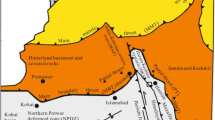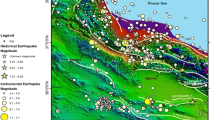Abstract
Through this paper we are presenting a study of seismic regionalization for continental Chile based on a neural network. A scenario with six seismic regions is obtained, irrespective of the size of the neighborhood or the range of the correlation between the cells of the grid. Unlike conventional seismic methods, our work manages to generate seismic regions tectonically valid from sparse and non-redundant information, which shows that the self-organizing maps are a valuable tool in seismology. The high correlation between the spatial distribution of the seismic zones and geological data confirms that the fields chosen for structuring the training vectors were the most appropriate.




Similar content being viewed by others
References
Gorshkov GP (1956) General survey of seismicity of the territory of the USSR. Public Bureau Central Seismologique International A19:25
Richter CF (1959) Seismic regionalization. BSSA 49:123
Gajardo E, Lomnitz C (1958) Seismic province of Chile. Publication 11:1529
Welkner P (1964) Estudio de la Sismicidad en Chile y su aplicacion al calculo antisismico. Thesis, Geophysics Department, University of Chile
Labbe JC (1976) Relaciones macrosismicas para la evaluacion del riesgo sismico en Chile y California
Barrientos SE (1980) Regionalizacion Sismica de Chile. M.Sc. Thesis, School of Engineering, University of Chile
Cornell C (1968) Engineering seismic risk analysis. Seism Soc Am Bull 58:1583–1606
Algermissen ST, Perkins DM (1976) A probabilistic estimate of maximum acceleration in rock in the contiguos United States. Geolog Surv Op.-File Rep 76–416
Martin A (1990) Hacia una regionalizacion y calculo del peligro sismico de Chile. Engineering Thesis, School of Engineering, University of Chile
Kahraman S, Baran T et al (2008) The effect of regional borders when using the Gutenberg-Richter model, case study: Western Anatolia. Pure Appl Geophys 165:2
Kohonen T (1990) The self-organizing map. Proc IEEE 78(9):1464
Rojas R (1996) Neural networks—a systematic introduction. Springer, Berlin
Delacou B, Sue C et al (2008) Quantification of strain rate in the Western Alps using geodesy: comparisons with seismotectonics. Swiss J Geosci 101:2
Pedone R, Lombardo P et al (1992) Seismotectonic regionalization of the Red Sea area and its application to seismic risk analysis. Nat Hazards 5:233
Dowla FU, Taylor SR, Anderson RW (1990) Seismic discrimination with artificial neural netwoks: preliminary results with regional spectral data. BSSA 80:1346
Wang J, Teng T-L (1995) Artificial neural network-based seismic detector. BSSA 85:308
Kim W-Y, Aharonian V, Lerner-Lam AL, Richards PG (1997) Discrimination of earthquakes and explosions in southern Russia using regional high-frequency three-component data from IRIS/JSP caucasus network. BSSA 87:569
Giacinto G, Paolucci R, Roli F (1997) Application of neural networks and statistical pattern recognition algorithms to earthquake risk evaluation. Pattern Recogn Lett 18:1353
Kerh T, Gunaratnam D, Chan Y (2009) Neural computing with genetic algorithm in evaluating potentially hazardous metropolitan areas result from earthquake. Neural Comput Appl. doi:10.1007/s00521-009-0301-z
Kerh T, Lai JS, Chan Y (2007) Application of neural network in evaluating seismic design parameters for metropolitan areas in Taiwan. In: Proceedings of the international conference on advanced information technologies 052:01–06
Pu Y, Mesbahi E (2006) Application of artificial neural networks to evaluation of ultimate strength of steel panels. Eng Struct 28:1190
Kerh T, Lai JS, Gunaratnam D, Saunders R (2008) Evaluation of seismic design values in the Taiwan building code by using artificial neural network. CMES-Comput Model Eng Sci 26(1):1
CERESIS Catalog (1985) Catalogo de terremotos para America del Sur
USGS. Web site: http://earthquake.usgs.gov/
Tutorial. Web page: http://www.ai-junkie.com/ann/som/som1.html
Yin H (2007) Learning nonlinear principal manifolds by self-organising maps. In: Gorban AN et al (eds) LNCSE 58. Springer, Berlin
Acknowledgments
JR wants to thank TGT for the support through grant number 2122 and 2123. VHC wants to thank Rafael Valdivia for useful discussions.
Author information
Authors and Affiliations
Corresponding author
Rights and permissions
About this article
Cite this article
Reyes, J., Cárdenas, V.H. A Chilean seismic regionalization through a Kohonen neural network. Neural Comput & Applic 19, 1081–1087 (2010). https://doi.org/10.1007/s00521-010-0373-9
Received:
Accepted:
Published:
Issue Date:
DOI: https://doi.org/10.1007/s00521-010-0373-9




